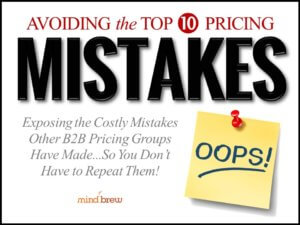For B2B companies, few things are more frightening than a price increase. People naturally worry that raising prices will scare off the customers. Volumes might go down. Revenues might go down. In the worst case scenario, perhaps a price increase could even drive the firm out of business.
However, as Helen Keller once wisely noted, “Avoiding danger is no safer in the long run than outright exposure. The fearful are caught as often as the bold.” You could suffer negative financial consequences just as easily from failing to make a price increase when one is needed as from making the price increase.
Having said that, there are some steps you can take to make a pricing increase a little less risky:
1. Avoid across-the-board moves to take a surgical approach. Certain product lines and pricing segments are always less price sensitive than others. Maybe you even have some areas where you’re currently leaving some value on the table. Those are the places where you want to make the biggest increases.
2. Use segmentation and elasticity to get even more where you can. In order to take that surgical approach, you need to do the calculations to figure out where the pricing increases will be the least painful. That requires a solid segmentation model and a good understanding of your price elasticity.
3. Support the increases with solid value reinforcement and rationale. Make sure your salespeople have a good story to tell about why the pricing increase is necessary. If increasing supply costs or rising tariffs are affecting your business, you might even be able to use those market dynamics as a justification for raising prices a little bit more than is strictly necessary.
4. Leverage non-price elements. Depending on your business model, you might be able to restructure your sales to make a price increase more palatable. For example, some companies have reduced their back-end rebates in order to increase margins without actually raising the sticker price for products.
5. Remember that your biggest battles are inside your own company. In every case, you will have to fight harder against your co-workers for a price increase than you will have to fight against your customers. But if you have solid data — including good segmentation and elasticity measurements — that can go a long way to making the pricing increase easier to accept.
For more tips, check out Corporate Survival Strategies for Raising Prices and Timing Your Pricing Actions for Success. Both cover best practices and potential pitfalls to avoid.
In the end, pricing increases are just a necessary part of doing business. If you can get your company to become accustomed to that idea, it will make the process of executing a price increase much smoother. As civil rights activist Rosa Parks said, “When one’s mind is made up, this diminishes fear; knowing what must be done does away with fear.”















